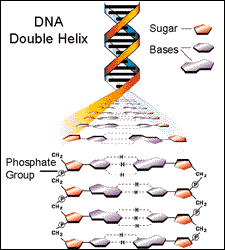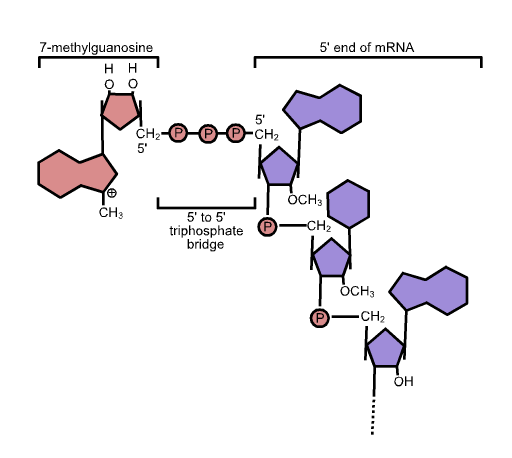Let's review the basic thing we learned from Molecular Biology! :) Actually I'm thinking if someone can design a toy for kids to learn DNA structure, something like a puzzle, each unit is a magnetic piece and they can only be assembled/aligned in certain direction. That would be cool!

Reference: http://passel.unl.edu/pages/informationmodule.php?idinformationmodule=957882007&topicorder=4&maxto=7
Each strand of DNA double helix is a chain of bases linked to the sugar-phosphate backbone. The two strands are connected with hydrogen bonds. As below:
The phosphate group is linked between the 5th carbon of an upstream sugar and 3rd carbon and a downstream sugar. The 5-carbon sugar is called deoxyribose in DNA and ribose in RNA, which can be distinguished by the loss or presence of an oxygen atom at the 2' carbon, as highlighted in red in the following figure.
- The sugar in RNA is a ribose sugar (as opposed to deoxy-ribose) and has an –OH at the 2' C position highlighted in red in the figure below (DNA sugars have –H at that position)
- Thymine in DNA is replaced by Uracil in RNA. T has a methyl (-CH3) group instead of the H atom shown in red in U.
Reference: http://tigger.uic.edu/classes/phys/phys461/phys450/ANJUM04/
Now let's see the cap structure of RNA:
Cap structure are most commonly added to the 5' of RNA, known as mRNA capping. The 5' capping, as the left brown part shown in following figure, is like a guanosine(G) nucleotide but with a methyl group added at the 7' in guanosine. Its 5' is connected to the 5' of RNA with a triphosphate bridge.
The following figure also contains a 2' cap, which can rarely happen in some eukaryote and viral genome.
Note that mitochondrial mRNAs don't have cap.
Reference: https://en.wikipedia.org/wiki/Five-prime_cap



Thanks for the sharing. I've learn more about DNA and RNA structure.
ReplyDelete-Caroline
Creative BioMart
DNA can organize chromosome structure in cells and the entire set of chromosomes are called the genome. Chromosome will copy before cell division and the process is called DNA replication.
ReplyDelete